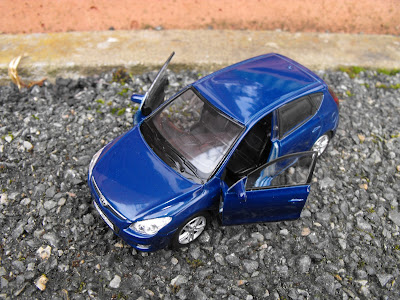Citroën DS was manufactured by Citroën from 1955 to 1975. The car was designed an Italian sculptor Flaminio Bertoni. The DS 19 was introduced in October 1955 at the Paris Motor Show and it was instantly recognised as the car of the future. The orders for the first day totalled 12,000. The car is known for its futuristic body design and innovative technology, including a hydropneumatic self-levelling suspension, that enhanced ride quality and handling.
Another famous technical innovation of the DS, were the directional headlights. They were introduced as an option on the DS in 1967 for the first time on a Citroën. Behind each glass cover lens, the inboard high-beam headlamp swivels by up to 80° as the driver steers, throwing the beam along the driver's intended path rather than uselessly across the curved road. In 1957 a new version, ID was introduced. It was a model with a weaker engine, less equipment and without the innovative technology, in order to reduce the costs. Effectively, it became the cheaper version of the DS.
As well as having the saloon, Citroën soon presented other bodystyles. These included the estate (introduced in 1958) and the very rare convertible (also introduced in 1958, withdrawn in 1973). The car was nicknamed by the French "Déesse" (goddess).
During the 20 years of production, almost 1.5 million Citroën DS were sold all around the world.
*********
Citroën DS wytwarzany był od 1955 do 1975 r. Samochód zaprojektował włoski rzeźbiarz Flaminio Bertoni. DS 19 zaprezentowane zostało w październiku 1955 r. na targach motoryzacyjnych w Paryżu i z miejsca okrzyknięto je autem przyszyszłości. Podczas pierwszego dnia złożono 12.000 zamówień. Samochód znany jest z futurystycznej linii nadwozia oraz innowacyjnej technologii, jak np. hydropneumatyczne samopoziomujące się zawieszenie, które bardzo podnosiło komfort jazdy. Kolejną słynną innowacją techniczną były skrętne reflektory. Wprowadzone jako opcja w 1967 r. po raz pierwszy w samochodzie marki Citroën. Każda lampa może przekręcić maksymalnie o 80° podczas skrętu kierownicą, dokładniej oświetlając zakręt przed kierowcą. W 1957 r. do produkcji wszedł nowy model ID (idée – czyli idea), ze słabszym silnikiem i uboższym wyposażeniem. Pozbawiono go wszystkich systemów hydraulicznych, poza zawieszeniem hydropneumatycznym. Tym samym stał się tańszą wersją DS-a.
Oprócz sedana Citroën przedstawił też inne wersje nadwozia. Było to kombi (od 1958 r.) oraz bardzo rzadko spotykany kabriolet (od 1958 do 1973 r.). Przez francuzów auto nazwane zostało „déesse”, czyli bogini. Przez 20 lat produkcji, sprzedano prawie 1,5 miliona egzemplarzy DS-ów na całym świecie.
 |
Citroën DS 19 1964 (1:43)
by Del Prado |

















































